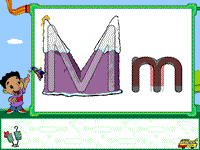
Alphabetic principle
English spelling is based upon the alphabetic principle, the idea that letters represent sounds. For example, the word pat is composed of three letters, p, a, and t, each representing a phoneme, respectively, /p/, /æ/, and /t/.[1] Some letters in English regularly represent one sound, such as b, m, p, and t. However, the alphabetic principle is not sufficient to represent all of the spellings in English.
Reading in English also requires understanding of additional patterns that do not follow the "one letter-one sound" principle. For example, the word shirt is composed of five letters which represent only three sounds, /?/, /?/, and /t/. The connections between spellings (also called graphemes) and sounds are called "sound-symbol correspondences" or "sound-spelling correspondences," among other names.
Sound-symbol correspondences often follow certain conventions, and these conventions are often called "phonics rules" or "phonics patterns." English has many phonics patterns. These vary considerably in the degree to which they follow the stated pattern. For example, the letters ee almost always represent /i/. On the other hand, the grapheme ough represents /?f/ as in enough, /o?/ as in though, /u/ as in through, /?f/ as in cough, and /?/ as in bought. Therefore, teachers generally teach that ee says /i/ but rarely teach a pattern for the letters ough. Because a large body of patterns that constantly conflict is antithetical to students remembering the patterns they are taught, elementary school children often learn a selection of these patterns known to be most consistent. A selection of these is given below, although not all of these are taught by teachers.



0 comments:
Post a Comment